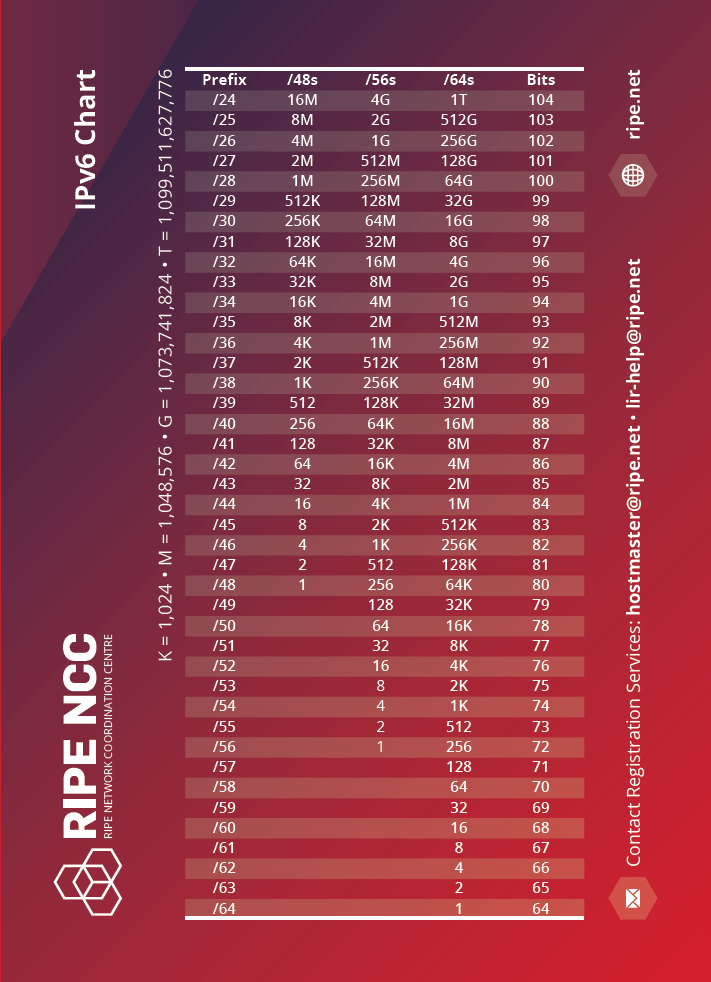

- #IPV4 ADDRESS SUBNETTING CHART HOW TO#
- #IPV4 ADDRESS SUBNETTING CHART CODE#
- #IPV4 ADDRESS SUBNETTING CHART ZIP#

In the following table, the red digits represent the bits used for the network.

Subnet masks can also be defined in a more common 'slash' representation, known as CIDR notation. The host portion is like the house and street number.Ī subnet defines the number of bits, out of 32, used for the "network portion" of the address.
#IPV4 ADDRESS SUBNETTING CHART ZIP#
The network portion is like the city, state, and zip code. There are two parts to an IP address: The network portion and the host portion. The process of taking an extensive network and splitting into smaller networks is known as subnetting - and it's freeing up more public IPv4 addresses. Luckily, the designers of IP addressing came up with a way to end this wasteful practice: Dividing networks using subnetting.
#IPV4 ADDRESS SUBNETTING CHART HOW TO#
How to define the network portion of a subnet IP addressĭuring the early stages of the internet, organizations assigned IP addresses like crazy until we nearly ran out. These are the most common octets you'll encounter in subnetting: When all the positions are "turned on," they add up to 255. So, 1 in the first and last positions "turn on" 128 and 1.Īdd up all the positions to get the decimal number: 128 + 1 = 129 Let's use this binary number, for example: 10000001Įvery 1 in a binary number "turns on" the number in its position. Hence the term octet or the 8-bit number grouping. Note that there are eight numbers between the decimal points. The biggest IP address possible is 255.255.255.255 Why do octets only go up to 255? Because they're binary. These octets range in number from zero to 255. To make addresses more straightforward, they are divided into four 8-bit numbers - or octets - separated by a decimal point. Here's what an IP address looks like: 192.168.1.20Īn IPv4 address is a 32-bit number. To understand subnetting, you should first understand the decimal and binary structure of an IP address. A quick rundown of IP addresses and binary It's used to free up more public IPv4 addresses and segment networks for security and easier management. Return a list of addresses for a subnet in order String subnetStr = "127.0.0.0/28" įor(IPAddress addr : subnet.The quick definition: Subnetting is the process of taking a network and splitting it into smaller networks, known as subnets. IPAddress broadcastAddr = subnet.getUpper() Return the broadcast address for a given subnet String subnetStr = "127.0.0.0/28" IPAddress subnet = subnetString.toAddress() īoolean isContained = ntains(addr) //true in this case IPAddressString subnetString = new IPAddressString(subnetStr)

Return if address is contained within a subnet String str = "1::1" IPAddressString addrString = new IPAddressString(str) Verify if an address is valid String str = "::1"
#IPV4 ADDRESS SUBNETTING CHART CODE#
In other words, it differs from most other utilities in the sense that the code below works identically with either IPv4 or IPv6 as the input strings. Disclaimer: I am the project manager.Īll the use cases you listed are supported for both IPv4 and Ipv6 transparently. The IPAddress Java library supports both IPv4 and IPv6 in a polymorphic manner including subnets.


 0 kommentar(er)
0 kommentar(er)
